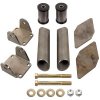Cage-frame tie-ins tranfer the energy of a roll, directly to the frame; as the body alone is NOT strong enough to support a multi-roll accident. Also, they help prevent latteral "sheer" of the cage mounting plates & bolts.
A good cage-frame tie-in kit will have the upper mount plate (inside the body) slightly smaller than the lower mount plate (bottom side of body.) This is to prevent sheer also. Think of it this way, if the mounting plates are the same size, then the edges of the plates will put stress on one, localized area, and it will "tear" the body right in two, granted the added fact of a frame-tie in does greatly reduce this, however it can still happen with one if the plates are the same size.
*IMHO* IF YOU HAVE A 2" or 3" BODY LIFT- THESE ARE AN ABSOLUTE MUST! .... If you get in an auto accident with a body lift, especially the larger ones, it is putting tons of torque on your body-mount bolts... (when your frame stops suddenly, the vehicle's body still wants to keep moving forward (newtons law haha) and can easily cause damage to the body mount locations; this includes breaking the bolts, cracking the rubber/polyurethane, or even ripping the mounting plates right off of the body.
-Even with that said, I do reccomend that all cages should have a tie-in kit...
Not to mention the fact that they will greatly reduce frame flexing while offroading, which can cause damage again to body mount systems, and the body itself.
The bushings are just to help absorb some of the shock in the event of a rollover, and to help keep the body and cage free of squeaks when hitting bumps etc...








